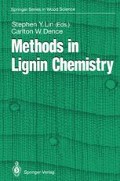Abstract
Carboxyl groups reportedly have been detected in native lignin, specifically in milled wood lignin, by infrared spectroscopy (Ekman and Lindberg 1960). However, the collective findings of a large number of structural studies indicate that if such groups are in fact present in native lignin, their concentration is extremely small. On the other hand, when native lignin is subjected to chemical (e.g., pulping and bleaching) or biological treatments, significant amounts of carboxyl groups are frequently detected. This effect is particularly pronounced in oxidative treatments where the resulting rupture of phenolic rings in the lignin gives rise to carboxyl-containing entities. Quantitative measurement of carboxyl groups may therefore provide information regarding the degree to which the lignin has been degraded or otherwise modified as the result of a specific chemical or biological treatment. The carboxyl content of a modified lignin may also provide information relating to its solubility characteristics and, for pulps, to strength properties.
Access this chapter
Tax calculation will be finalised at checkout
Purchases are for personal use only
Preview
Unable to display preview. Download preview PDF.
References
Chum HL, Ratcliff M, Schroeder HA, Sopher DW (1984)Electrochemistry of biomass-derived materials. I. Characterization, fractionation, and reductive electrolysis of ethanol- extracted explosively depressurized aspen lignin. J Wood Chem Technol 4: 505–532
Crozier TE, Johnson DC, Thompson NS (1979) Changes in a southern pine dioxane lignin on oxidation with oxygen in sodium carbonate media. Tappi 62: 107–111
Ekman K, Enkvist T (1955) Some determinations of weak and strong acids in various lignin preparations and pulps. Pap Puu 37: 369–382
Ekman KH, Lindberg JJ (1960) On the origin of the infra-red bands in the 1720cm 1 region in lignins. Pap Puu 42: 21–22
Enkvist T, Alm B, Holm B (1956) Some experiments concerning the acidic groups of lignin. Pap Puu 38: 1–8, 12
Forss K, Fremer K-E (1978) Potentiometrie titration of the acidic groups in lignosulfonic acids. Pap Puu 60: 121–127
Gaslini F, Nahum LZ (1959) Conductometric titration of alkali lignin. Sven Papperstidn 62: 520–523
James AN, Tice PA (1965) The presence of carboxyl groups in lignosulfonate preparations. Tappi 48: 239 - 244
Katz S, Beatson RP, Scallan AM (1984) The determination of strong and weak acidic groups in sulfite pulps. Sven Papperstidn 87: R48–R53
Kirk TK, Chang H-m (1975) Decomposition of lignin by white-rot fungi. II. Characterization of heavily degraded lignins from decayed spruce. Holzforschung 29: 56–64
Klemola A (1968) Steam hydrolysis of birchwood. Part V. An investigation of the carbonyl and carboxyl groups in the degraded lignin. Suom Kemistil B41. 152–160
Marton J, Adler E (1963) Reactions of lignin with methanol hydrochloric acid. A discussion of some structural questions. Tappi 46: 92–96
Mikawa H, Sato K, Takasaki C, Ebisawa K (1956) Studies on the cooking mechanism of wood. XIII. On the possible hydroxyl group of lignosulfonic acid. Bull Chem Soc Jpn 29: 245–254
Morck R, Yoshida H, Kringstad KP, Hatakeyama H (1986) Fractionation of kraft lignin by successive extraction with organic solvents. I. Functional groups, 13C-NMR-spectra and molecular weight distributions. Holzforschung 40 (Suppl): 51–60
Pobiner H (1983) Improved inflection points in the non-aqueous potentiometric titration of acid functionalities in lignin chemicals by using internal standardization and ion exchange. Anal Chim Acta 155: 57–65
Scalbert A, Monties B (1986) Comparison of wheat straw preparations. II. Straw lignin solubilization in alkali. Holzforschung 40: 249–254
Editor information
Editors and Affiliations
Rights and permissions
Copyright information
© 1992 Springer-Verlag Berlin Heidelberg
About this chapter
Cite this chapter
Dence, C.W. (1992). Determination of Carboxyl Groups. In: Lin, S.Y., Dence, C.W. (eds) Methods in Lignin Chemistry. Springer Series in Wood Science. Springer, Berlin, Heidelberg. https://doi.org/10.1007/978-3-642-74065-7_31
Download citation
DOI: https://doi.org/10.1007/978-3-642-74065-7_31
Publisher Name: Springer, Berlin, Heidelberg
Print ISBN: 978-3-642-74067-1
Online ISBN: 978-3-642-74065-7
eBook Packages: Springer Book Archive

